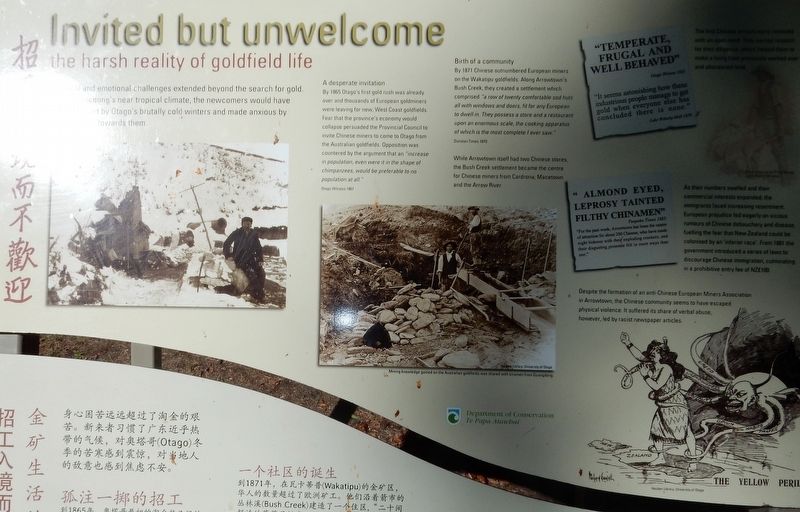Arrowtown in Queenstown-Lakes District, Otago, New Zealand — Southwestern Pacific Ocean
Invited but Unwelcome
The harsh reality of goldfield life
A desperate invitation
By 1865 Otago's first gold rush was already over and thousands of European goldminers were leaving for new, West Coast goldfields. Fear that the province's economy would collapse persuaded the Provincial Council to invite Chinese miners to come to Otago from the Australian goldfields. Opposition was countered by the argument that an “increase in population, even were it in the shape of chimpanzees, would be preferable to no population at all.” Otago Witness 1867
Birth of a community
By 1871 Chinese outnumbered European miners on the Wakatipu goldfields. Along Arrowtown's Bush Creek, they created a settlement which comprised “a row of twenty comfortable sod huts all with windows and doors, fit for any European to dwell in. They possess a store and a restaurant upon an enormous scale, the cooking apparatus of which is the most complete I ever saw.” Dunstan Times 1870
While Arrowtown itself had two Chinese stores, the Bush Creek settlement because the centre for Chinese miners from Cardrona, Macetown and the Arrow River.
[Sidebar — newspaper excerpts]
The first Chinese arrivals were received with an open mind. They earned respect for their diligence, which helped them to make a living from previously worked over an abandoned land.
As their numbers swelled and their commercial interests expanded, the immigrants faced increasing resentment. European prejudice fed eagerly on vicious rumours of Chinese debauchery and disease, fuelling the fear that New Zealand could be colonised by an “inferior race”. From 1881 the government introduced a series of laws to discourage Chinese immigration, culminating in a prohibitive entry fee of NZ£100.
Despite the formation of an anti-Chinese European Miners Association in Arrowtown, the Chinese community seems to have escaped physical violence. It suffered its share of verbal abuse, however, led by racist newspaper articles.
Captions/credits
[Center] Mining knowledge gained on the Australian goldfields was shared with kinsmen from Guangdong. Hocken Library, University of Otago
[Right, top] From a mural by Ping Wang.
[Right, bottom] Hocken Library, University of Otago
[The Chinese portion of this marker was not transcribed]
Erected by New Zealand Department of Conservation.
Topics. This historical marker is listed in these topic lists: Industry & Commerce • Settlements & Settlers. A significant historical year for this entry is 1865.
Location. 44° 56.253′ S, 168° 49.705′ E. Marker is in Arrowtown, Otago, in Queenstown-Lakes District. Marker can be reached from Buckingham Street north of Villiers Street, on the left when traveling north. Marker is in Arrowtown Chinese Settlement. Touch for map. Marker is in this post office area: Arrowtown, Otago 9302, New Zealand. Touch for directions.
Other nearby markers. At least 1 other marker is within walking distance of this marker. Welcome to the Arrowtown Chinese Settlement (within shouting distance of this marker).
Credits. This page was last revised on October 28, 2021. It was originally submitted on October 27, 2021, by Duane and Tracy Marsteller of Murfreesboro, Tennessee. This page has been viewed 216 times since then and 9 times this year. Photo 1. submitted on October 27, 2021, by Duane and Tracy Marsteller of Murfreesboro, Tennessee.
